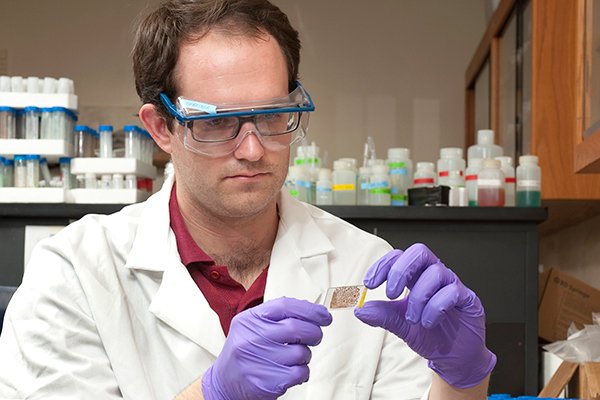
A groundbreaking study
Research on trace metals in soil highlighted in Nature Communications
3:41 p.m., Sept. 22, 2014--A research team at the University of Delaware has developed a new method for observing chemical reactions in real and rapid time at the boundaries between soil mineral particles and water.
Details of the new method and the revealing data obtained with it were published Sept. 19 in the prestigious scientific journal Nature Communications.
Research Stories
Chronic wounds
Prof. Heck's legacy
According to lead author Matt Siebecker, a former doctoral student in the Department of Plant and Soil Sciences, the research will benefit the design of cost-effective remediation strategies for contaminated soils as well as improve conceptual models of what happens to metal ions in soils.
Trace metals such as nickel, cobalt and zinc can be toxic to living organisms, but their level of toxicity often depends on what chemical form these metals take. They tend to be more toxic in forms that can dissolve in water, since that makes it easier for organisms to absorb the metals into their cells and tissues. A more insoluble form decreases metal bioavailability.
Siebecker, who conducted his doctoral research with his co-author Donald Sparks, S. Hallock du Pont Chair of Soil and Environmental Chemistry at UD, says learning how metal ions, either alone or in combination, react with the surfaces of soil particles under various conditions is the key to understanding the fate and transport of metals in the environment.
To find out, Siebecker, Sparks, and their two co-authors, postdoctoral fellow Wei Li and Brookhaven scientist Syed Khalid, created a custom-built flow cell — a microcosm for holding soil samples that allows water to flow through the chamber as the sample is being analyzed. The flow cell enabled the researchers to simulate the environment much more realistically than in previous studies.
They used the flow cell in conjunction with an advanced tool for measuring chemical composition at the molecular level, quick-scanning extended X-ray absorption fine structure (Q-EXAFS) spectroscopy at the National Synchrotron Light Source at Brookhaven National Laboratory.
With this novel experimental setup, the team was able to show that metal adsorption (a binding surface reaction) and precipitation (a reaction in which a solid substance forms from a solution) both take place in a matter of minutes following the introduction of the metal.
“Prior to this study, we didn’t know that these two processes were occurring on similar time scales,” Siebecker said. “Not only that, but the time scales are both very short.”
In the late 1990s, Sparks’ research group was the first to identify mixed metal precipitates that formed on soil minerals. Subsequently, they found that these precipitates occurred naturally in soils contaminated with metals such as nickel and zinc, and that once the precipitates form, the metal is sequestered in a form that makes it very resistant to leaching in soil and water and relatively unavailable to organisms.
“We always wondered how rapidly the precipitate phases formed,” Sparks said, “and could they form on time scales concurrent to adsorption processes? But the methodology and technology were not yet available to measure rapid processes under in-situ, real-time conditions at the molecular scale.”
The value of this new research is that with their innovative method, the researchers were able to show that the precipitate phases form easily, indicating that the metal quickly assumes a form that limits its mobility in the environment.
“One method for treating metal-contaminated soils is in situ remediation,” Siebecker said, “where soil additives are used to immobilize and stabilize mobile contaminants. Our study showed that one of these stabilization processes — the formation of new, metal-rich precipitates — can occur quickly.”
“The results also mean that models that have typically ignored the formation of metal precipitate phases need to include them,” Sparks added, “if accurate predictions are going to be made about the fate and transport of toxic metals in the environment.”
Article by Beth Chajes
Photo by Kathy F. Atkinson








